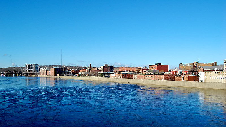
Modern Haverhill
The U.S. Housing Act of 1949 earmarked funds for
a country-wide Urban Renewal Programme which is most commonly remembered
for large-scale central city demolitions.
At the time, historic downtowns were considered “blighted”
or “obsolete”, and the Programme provided funds to demolish
old buildings and replace them with contemporary monstrosities, which
would form the basis of a modern downtown.
The Programme was widely embraced at the time, but is now largely looked upon as a failure. Under mayor Jim Waldron, Haverhill was one of those American cities that pursued Urban Renewal funds, and in just a decade (1966-1976), many of Haverhill’s 17th and 18th century houses were destroyed, along with nearly every public building of architectural significance and half of the downtown commercial buildings.
Urban Renewal was meant to spur re-development by creating incentives for developers, but federal funds dried up and Haverhill became one of many cities that bull-dozed its own heritage for a promise that was not fulfilled. Long-time residents of the city remember the huge ‘dust-bowl’ where the library, courthouse, and old city hall once stood.
Many claim that Urban Renewal destroyed the vitality of
downtown Haverhill and the close relationship of its residents to downtown.
When old buildings were condemned, the city offered incentives for businesses
to relocate to the edges of town, and, as a result, many of the grand
old houses along Main Street and South Main Street were converted into
professional offices.
This has resulted in a diminution of pedestrian traffic
in town, and, in the view of many, all this has resulted in a disjointed
city where residents must drive from place to place, and where businesses
are not co-located to benefit from each other. In the words of one resident:
“Urban Renewal was a failure for Haverhill, and we are still suffering
its consequences today.
The fine federal and Victorian buildings that were constructed during
Haverhill’s economic peaks were replaced by bland offices, parking
lots and strip malls.
As it now stands, Haverhill MA occupies an area
of just over 34 square miles (of which 2.3 square miles is represented
by water). The Merrimack River flows twelve miles through the heart of
the city.
There are 232 miles of road and three airports. Modern Haverhill is a
vibrant city which would amaze the settlers who worked so hard to found
it over 300 years ago.
There are four specific industrial parks in Haverhill but
the city also has a multitude of industrial and commercial property in
a variety of locations. As well as modern successful businesses there
is also a successful leisure industry and visitors can ski on the popular
ski slopes in the winter or in the summer enjoy the many boat trips available
on the Merrimack River.
Sports fans can play a round of golf on one of the many 18-hole courses
and participate in games at the Riverside baseball parks.
There is also a thriving downtown arts district with music, cinema and arts venues as well as historic examples of the old shoe making factories. Visitors can also choose to eat in one of the seventeen restaurants located downtown.
For more information on Haverhill MA then go to one of the many websites on the town including: www.haverhillmeansbusiness.com
HAVERHILL MASSECHUSETTS USA
A Life Feature by Ian Hornsey





Part 1 The Early Years Part 2 The Early Years cont.. Part 3 Haverhill Massechusetts 19th Century
Part 4 Haverhill Massechusetts 20th Century
Part 6 Haverhill MA and
the Abolition of Slavery